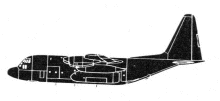Incident Overview

Description
A Lockheed Hercules transport plane, N402LC, sustained substantial damage during landing at the Hog River Airport, a private airport about 40 miles north of Huslia, Alaska. The airplane was being operated as an instrument (IFR) cross-country cargo flight when the accident occurred. The flight originated at the Fairbanks International Airport, Alaska, about 12:47. The captain indicated he flew over runway 30 to inspect the runway, and observe the wind sock, which is located at the north end of the runway. The wind direction from the wind sock, a comparison of the airplane’s airspeed, and ground speed indication from a global positioning system receiver (GPS), revealed variable wind conditions that were less than 10 knots. The captain decided to land toward the north, and planned to touch down in the first few hundred feet of the approach end of runway 30. During the landing flair, the airplane floated slightly, and then touched down about 1,200 feet beyond the approach end of the runway. After touch down, the captain lowered the nose of the airplane, and brought the engines into reverse. As the airplane decelerated, it drifted slightly to the left, but the captain indicated he did not notice any collision with any objects. After the airplane was parked, the crew noticed damage to the leading edge of the left wing, about 18 inches inboard from the tip. An inspection of the leading edge revealed a collision with about a 3 inch diameter tree. The wing received aft crushing, damage to a wing nose rib, and slight denting of the wing spar web. The airplane has a wing span of 132 feet, 7 inches. The wing is 15 feet, 3 inches above the ground. PROBABLE CAUSE: “The pilot’s failure to maintain proper alignment of the airplane during the landing roll.”
Primary Cause
Pilot’s failure to maintain proper alignment of the airplane during the landing roll.Pilot’s failure to maintain proper alignment of the airplane during the landing roll.Share on:





